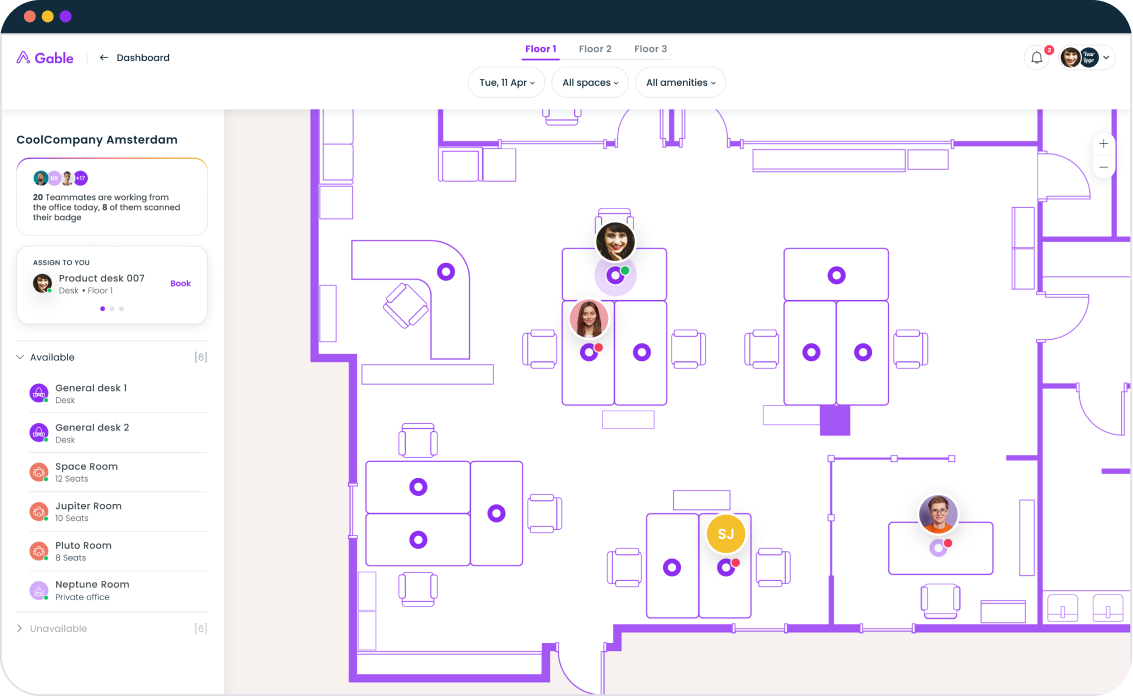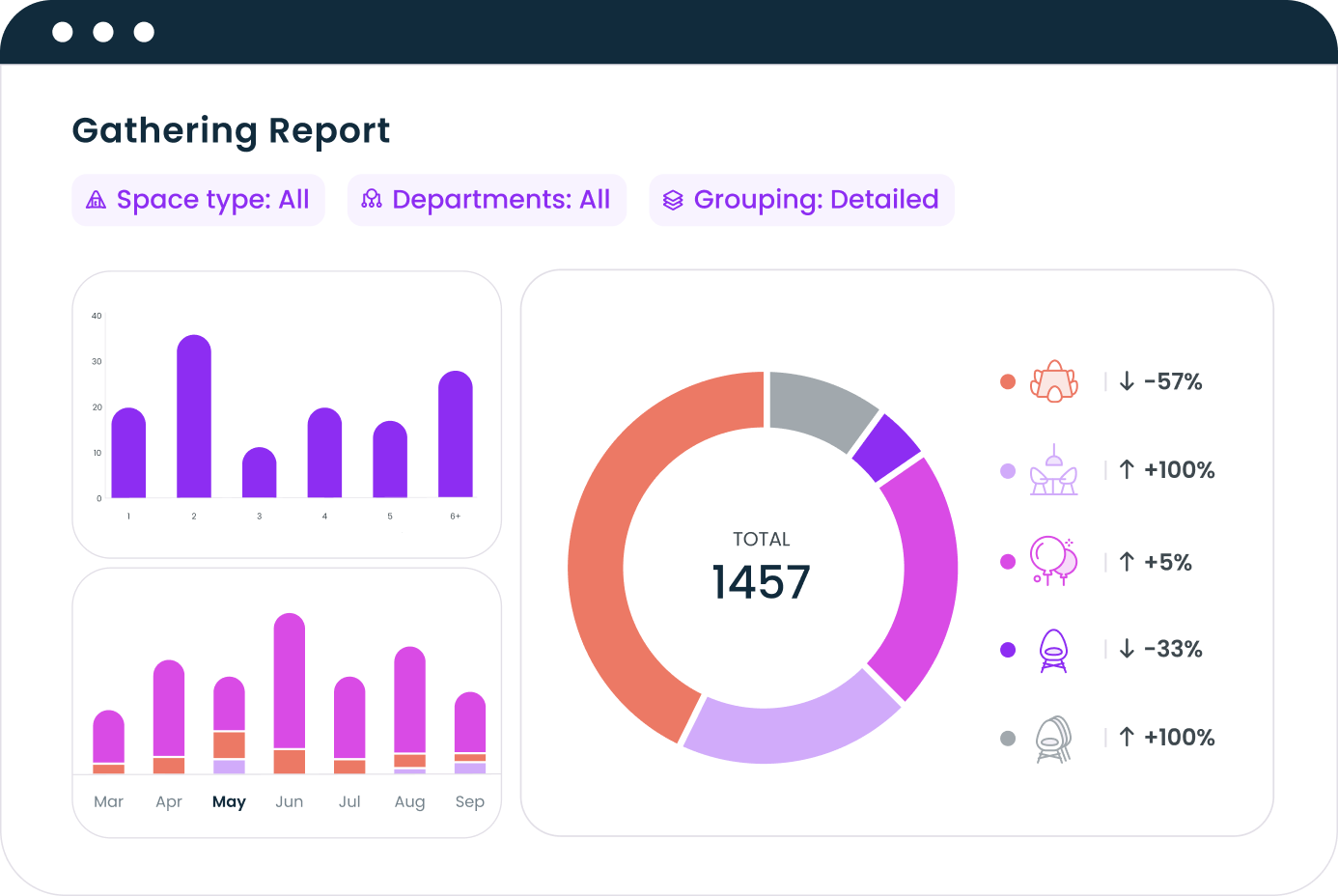Employee engagement has dropped to just 21% globally while 92% of companies increase AI investments, creating both unprecedented challenges and $9.6 trillion productivity opportunities for workplace leaders who adapt with data-driven strategies.
The workplace landscape of 2025 is changing and demands strategic responses from workplace, real estate, facilities, and people professionals. While headlines focus on return-to-office mandates and AI disruption, the real story lies in how smart organizations are turning these challenges into competitive advantages.
The data reveals a stark paradox: McKinsey research sizes the long-term AI opportunity at $4.4 trillion in added productivity growth potential, yet global employee engagement has declined to 21% in 2024.
This article explores 12 workplace trends that will define 2025 and beyond: from AI integration and hybrid work evolution to demographic shifts and sustainability demands, providing workplace professionals with insights they need to stay ahead of the curve.
1. The engagement crisis reaches critical mass
Manager engagement fell from 30% to 27% in 2024, with young managers experiencing a five-point drop and female managers seeing a seven-point decline. This is a workplace strategy crisis that ripples through organizational performance, since 70% of team engagement is attributable to managers.
Managers are often caught between executive decisions and shifting employee expectations about mental health support, work-life balance, and flexible work schedules, yet they operate without adequate tools or training.
Forward-thinking HR teams are redesigning management support systems and implementing new technologies to ensure managers get the specialized skills they need to navigate complex work environments.

Explore exclusive workplace trends from Gable’s 2025 data report based on thousands of bookings across global flex spaces.
Get your copy
2. AI transforms workplace management and decision-making
Over the next three years, 92% of companies plan to increase their AI investments, but only 1% of leaders call their companies "mature" on AI deployment. For workplace professionals, AI's biggest impact is in optimizing space utilization and analyzing workplace data.
AI-powered systems now track occupancy patterns, predict space demand, and analyze employee movement data to recommend office layouts. Workplace leaders use AI to process booking data, identify underutilized areas, and optimize energy use based on real-time numbers. This turns overwhelming amounts of raw data into actionable insights for space planning and resource allocation.
The World Economic Forum's Future of Jobs Report 2025 shows broadening digital access as the most transformative trend, with 60% of employers expecting it to transform their business by 2030. For workplace teams, this means AI becomes essential infrastructure for managing complex, distributed work environments efficiently.
3. Hybrid work models reach strategic maturity
The conversation around hybrid and remote work has moved toward outcome-based strategies. 89% of American workers need a sense of team collaboration and belonging to stay satisfied long-term, placing new challenges on how companies design in-person experiences for the modern workforce.
Successful hybrid work models focus on work outcomes rather than attendance policies. Companies use workplace analytics to understand when face-to-face collaboration creates value, how different office spaces support various work models, and which technology investments boost productivity.
This shift requires companies to prioritize value creation during in-person time over maximizing occupancy. Traditional metrics like cost per square foot become less relevant when you demonstrate clear connections between space design and business outcomes through better technology and data-driven decisions.
4. The four-day workweek gains traction
Organizations worldwide are piloting shorter workweeks as employee demands for better work-life balance intensify. Iceland's large-scale trials showed productivity was maintained or increased while employee well-being improved significantly. Belgium recently gave workers the legal right to a four-day week, and companies from Microsoft Japan to Shopify have reported positive results.
The workplace implications are substantial. Organizations testing four-day workweeks often need to redesign office utilization strategies, rethink meeting schedules, and optimize space usage for more concentrated work periods. Some companies are using the extra day off to reduce overall office space requirements, while others are using it to create more intensive collaboration days.
For workplace professionals, this trend means planning for different occupancy patterns, potentially higher utilization on working days, and the need for spaces that support more focused, productive work when employees are in the office.
5. Reskilling demands reshape training spaces
By 2030, activities accounting for up to 30% of current work hours could be automated, yet emerging technologies like AI are more likely to enhance, not eliminate, most jobs. The skill gap is the highest in talent management, teaching and mentoring, and environmental stewardship: skills that require hands-on learning and professional development.
The shift toward shaping talent rather than hiring externally increases the importance of upskilling and reskilling programs. Companies are converting underutilized conference rooms into training spaces, creating areas for hands-on workshops, and designing spaces that support mentoring relationships.
The workplace implication is practical: organizations need more flexible spaces that can accommodate training sessions, workshops, and collaborative learning. This might mean modular furniture, better AV equipment for training, and spaces designed for small group instruction rather than large presentations.
6. Employee well-being becomes a workplace priority
41% of employees report feeling stressed "a lot of the day", with high levels of sadness (23%), loneliness (22%), and anger (21%). Smart employers are recognizing that supporting employee wellbeing isn't just the right thing to do—it's essential for productivity and retention.
Remote work correlates with higher loneliness (27% for exclusively remote workers), which is driving organizations to be more intentional about creating connection opportunities during in-person time.
Forward-thinking companies are making practical changes to support their people: better lighting to combat seasonal mood changes, sound masking to create calmer environments, and ensuring employees have access to private spaces when they need to handle personal matters during the workday. These modifications directly impact productivity and retention rates while showing employees that their well-being matters.
7. Economic pressures reshape real estate strategies
Geoeconomic fragmentation and geopolitical tensions drive business model transformation in one-third of surveyed organizations. These macroeconomic forces compel organizations to rethink workplace location, space commitments, and real estate portfolios for better business outcomes.
Traditional long-term office leases are being replaced by distributed approaches, adapting to changing economic conditions. Organizations reduce fixed real estate commitments while increasing investments in flexible workspace solutions, scaling based on business needs, and reducing energy consumption.
This shift requires workplace professionals to manage networks of flexible spaces providing geographic resilience. Organizations with distributed space portfolios are better equipped to weather local disruptions, adapt to changing talent markets, and respond to evolving requirements without long-term real estate constraints affecting their workforce planning.
Reserve desks effortlessly, optimize office utilization, and boost collaboration with the most affordable, data-driven desk booking software on the market.
Explore Gable Office Management
8. Sustainability drives innovation beyond efficiency
Climate-change mitigation ranks as the third-most transformative trend, with 47% of employers expecting it to transform their business. Sustainability becomes a core workplace design requirement rather than an optional addition, driving innovation in office spaces and work environment approaches.
The focus shifts from reactive energy efficiency toward proactive design strategies supporting broader sustainability goals. This includes optimizing space utilization, reducing environmental footprint, designing for adaptability, extending building lifecycles, and creating workplace experiences supporting sustainable commuting patterns.
Organizations discover that sustainability initiatives align with workplace priorities. Flexible workspace strategies reduce overall space requirements, hybrid models lower carbon emissions, and optimized utilization improves environmental and financial performance while designing workplaces supporting eco-friendly materials and practices.
9. Data-driven decisions become standard
Only 12% of HR teams do strategic workforce planning with a three-year focus, yet organizations embracing data-driven workplace strategies significantly outperform those relying on intuition. Real-time workplace data transforms how decisions get made across various industries.
Organizations now track space utilization patterns, measure collaboration environment effectiveness, and correlate workplace investments with business outcomes. This data revolution makes workplace strategy more scientific and results-oriented, enabling better decision-making about work hours, scheduling interviews, and office space optimization.
Smart workplace professionals build measurement frameworks connecting workplace metrics with organizational goals. This includes tracking utilization data, employee satisfaction scores, and the impact of workplace changes on productivity.
10. Technology integration enables seamless collaboration
The rise of workplace technology creates opportunities for more workers to collaborate effectively across time zones and locations. AI tools reduce email usage by 32% and meetings by 23%, with 91% of users reporting improved remote work capabilities for distributed teams.
Investment in better technology supporting asynchronous collaboration accommodates diverse schedules and improves efficiency across global teams. IoT devices and smart building technologies optimize energy use while providing data insights for workspace management and employee experience enhancement.
Organizations investing in hybrid-friendly workplace technology see improved transitions between remote and in-office work. This includes AI-powered video conferencing, digital collaboration tools, and workspace booking platforms.
11. Employee resource groups influence space planning
Diversity, equity, and inclusion initiatives increasingly affect workplace design decisions. Employee resource groups and DEI initiatives now provide input on everything from accessibility improvements to cultural space needs, influencing office layout and amenity decisions.
Organizations recognize that diverse teams drive better decision making, with companies in the top quartile for diversity 36% more likely to outperform peers in profitability. ERGs help identify practical needs like prayer/meditation spaces, lactation rooms, and accessibility improvements that workplace teams might otherwise overlook.
12. Future challenges require integrated solutions
Looking ahead, the workplace trends shaping 2025 require coordinated responses addressing immediate needs and long-term opportunities. The most successful organizations treat workplace strategy as a competitive advantage rather than a cost center, recognizing how thoughtful workplace design supports business leaders and team productivity.
Key priorities include integrated technology and human experience design, manager support systems addressing engagement decline, flexible space portfolios adapting to changing business requirements, and measurement frameworks connecting workplace investments with outcomes supporting the future of work.
Organizations investing in holistic workplace strategies: combining data-driven space optimization, employee wellbeing support, and technology integration, position themselves to capture the potential $9.6 trillion productivity opportunity while navigating the future challenges of an evolving workplace landscape.
Learn how Gable helps you conect people, spaces, and data to drive collaboration and savings in hybrid, remote-first, or office-based companies. v
Get a demo





.svg)





.svg)
















.svg)













